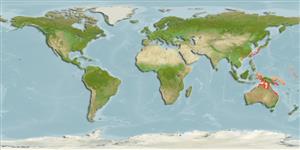分類 / Names
共通名の | 類義語 | Catalog of Fishes(部類, 種) | ITIS | CoL | WoRMS | Cloffa
>
Dactylopteriformes (Flying gurnards) >
Pegasidae (Seamoths)
Etymology: Pegasus: Taken form the winged horse of Perseus in the ancient Greek, mithology (Ref. 45335).
Environment: milieu / climate zone / depth range / distribution range
生態学
海 深海魚; 深さの範囲 10 - 45 m (Ref. 117113). Tropical
Western Pacific: Australia.
サイズ / 重さ / 年齢
Maturity: Lm ? range ? - ? cm
Max length : 9.8 cm SL オス/雌雄の選別がない; (Ref. 117113)
簡単な記述
検索表 | 形態学 | 形態計測学
背鰭 (合計) : 5; 臀鰭: 5. This species is distinguished by the following characters: 12 tail rings with the anteriormost 9 mobile, articulating laterally, and remaining 3 are fused together, attenuated and dorsoventrally flattened; terminodorsal-lateral (tdl) and terminoventral-lateral (tvl) plates each with an anteriorly and posteriorly directed spine; no terminal-lateral plates (tl); with interpectoral plate (ip); with a single ventral preopercular notch; spatulate rostrum; carapace with 3 small posteriorly directed tubercles along each of the dorsal ridge, one at the centre of each dorsal plate; no scales on orbit; pectoral-fin soft rays 9-10 (usually 10), the 5th ray stouter than other rays; 7 abdominal centra, 14 caudal centra, 21 total centra; 4 dark saddles on tail and without dark saddle on tail ring XI (Ref. 117113).
Life cycle and mating behavior
Maturities | 繁殖 | Spawnings | Egg(s) | Fecundities | 幼生
Osterhage, D., J.J. Pogonoski, S.A. Appleyard and W.T. White, 2016. Integrated taxonomy reveals hidden diversity in northern Australian fishes: A new species of seamoth (Genus Pegasus). PLoS ONE 11(3):e0149415. doi:10.1371/journal.pone.0149415 (Ref. 117113)
Human uses
用具
特記事項
XMLをダウンロードして下さい
インターネットの情報源
Estimates based on models
Phylogenetic diversity index (Ref.
82804): PD
50 = 0.5781 [Uniqueness, from 0.5 = low to 2.0 = high].
Bayesian length-weight: a=0.01000 (0.00244 - 0.04107), b=3.04 (2.81 - 3.27), in cm total length, based on all LWR estimates for this body shape (Ref.
93245).
栄養段階 (Ref.
69278): 3.3 ±0.4 se; based on size and trophs of closest relatives
Fishing Vulnerability (Ref.
59153): Low vulnerability (10 of 100).
